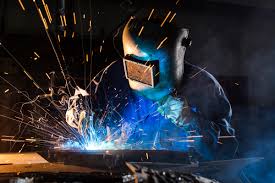
Fabrication & Welding: Understanding Mastering the Art
4 min read
09 April
In the realm of creation and construction, few skills are as vital as fabrication and welding. From building structures to crafting intricate designs, the fusion of metalwork and craftsmanship opens doors to endless possibilities. In this guide, we'll explore the intricacies of fabrication & Welding, from techniques to safety measures, helping you master the craft.
Understanding Fabrication & Welding
Fabrication & welding are essential in various industries, including construction, automotive, and manufacturing. Fabrication involves creating metal structures through cutting, bending, and assembling, while welding is the process of joining metal pieces using heat and pressure.
The Art of Fabrication
Manufacturing involves a diverse range of skills and techniques, from shaping raw materials to assembling components. It requires precision, creativity, and attention to detail to bring concepts to life through craftsmanship.
The Science of Welding
Welding is both a science and an art, requiring an understanding of metallurgy, heat management, and structural integrity. Different techniques, such as MIG (Metal Inert Gas) and TIG (Tungsten Inert Gas) welding, offer unique advantages suited to various applications.

Safety Measures in Fabrication & Welding
Safety is paramount in fabrication & welding due to the inherent risks of working with metal and heat. Proper protective gear, ventilation, and adherence to safety protocols can prevent accidents and ensure a safe working environment.
Personal Protective Equipment (PPE)
When engaging in manufacturing & welding activities, wearing appropriate PPE is essential. This includes safety goggles, welding helmets, gloves, and flame-resistant clothing to protect against sparks and debris.
Ventilation and Fume Extraction
Exposure to welding fumes can pose health risks, including respiratory issues and lung damage. Effective ventilation systems and fume extraction units help remove hazardous particles from the air, safeguarding worker health.
Advanced Techniques in Fabrication & Welding
Beyond the basics, advanced techniques push the boundaries of fabrication & Welding, allowing for the creation of intricate designs and structural masterpieces.
Precision Machining
Precision machining uses specialized tools and machinery to achieve precise metal fabrication. Techniques like CNC (Computer Numerical Control) machining, laser cutting, and waterjet cutting ensure accuracy in manufacturing.
Robotic Welding
Robotic welding systems offer speed, consistency, and precision in welding applications. By automating the welding process, manufacturers can enhance productivity and quality while reducing labor costs.
The Future of Fabrication & Welding
As technology advances, so does the landscape of manufacturing & welding. Innovations like 3D printing, advanced materials, and augmented reality are revolutionizing the design and construction processes.
3D Printing in Metal Fabrication
3D printing, or additive manufacturing, has emerged as a disruptive force in manufacturing. By layering metal powders or filaments, 3D printers can produce complex geometries with efficiency and customization.
Augmented Reality Welding Simulators
Augmented reality (AR) welding simulators provide immersive learning experiences for trainees to practice welding techniques in virtual environments. These simulators offer a safe and cost-effective way to develop skills and troubleshoot welding challenges.
Fabrication & Welding FAQs
How do I choose the right welding technique for my project?
Selecting the appropriate welding technique depends on factors such as metal type, joint design, and desired weld characteristics. Consult experienced welders or engineers for guidance.
What safety precautions should I take when welding?
Always wear proper protective gear, ensure adequate ventilation, and follow safety procedures. Regularly inspect welding equipment for defects and maintain a clean work area to minimize hazards.
Is welding a lucrative career option?
Welding offers diverse career opportunities across industries, with potential for advancement. Skilled welders are in demand, and certifications or specialized training can enhance earning potential.
Can I weld different types of metals together?
While welding dissimilar metals is possible, compatibility and proper techniques are essential for strong, durable joints. Refer to welding charts or seek expert advice for suitable procedures.
What are common welding defects, and how can they be prevented?
Common defects include porosity and lack of fusion, which compromise weld quality. Preventive measures include maintaining proper fabrication & Welding parameters and ensuring clean base metal surfaces.
In case you have found a mistake in the text, please send a message to the author by selecting the mistake and pressing Ctrl-Enter.
Fransisco Mask 2
Flash Uganda Media is a youth inspired online media platform designed to meet the needs of the very changing social world. We Publish all types of news ranging...

No comments yet